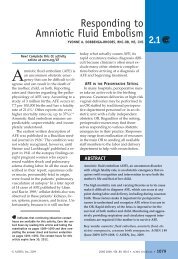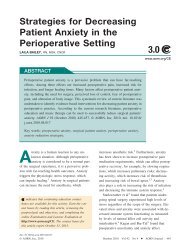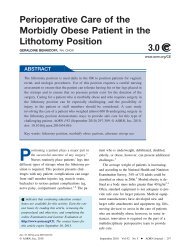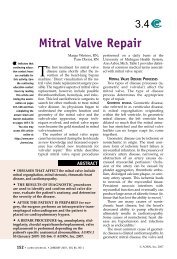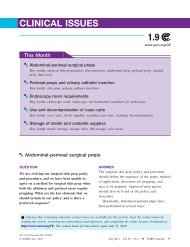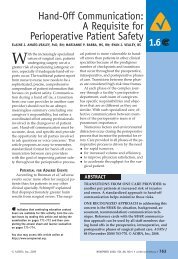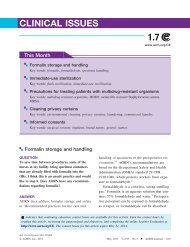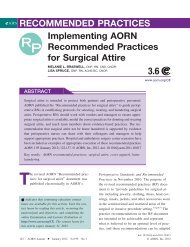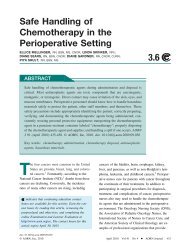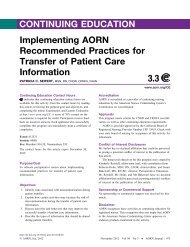Perioperative Care of the Patient with Diastolic Heart Failure ... - AORN
Perioperative Care of the Patient with Diastolic Heart Failure ... - AORN
Perioperative Care of the Patient with Diastolic Heart Failure ... - AORN
Create successful ePaper yourself
Turn your PDF publications into a flip-book with our unique Google optimized e-Paper software.
June 2011 Vol 93 No 6 CE EXAMINATION6. Common causes <strong>of</strong> DHF include1. ischemic heart disease.2. hypertension.3. hypertrophic cardiomyopathy.4. pericarditis.5. restrictive cardiomyopathy.6. valvular heart disease.a. 1, 3, and 5 b. 2, 4, and 6c. 1, 2, 3, and 5 d. 1, 2, 3, 4, 5, and 67. The symptom <strong>of</strong> DHF that usually is noted first isa. ankle and leg edema.b. dizziness or ligh<strong>the</strong>adedness.c. exercise intolerance <strong>with</strong> shortness <strong>of</strong> breath.d. whole body edema.8. _____________________________ should beaggressively treated before surgery to reduce <strong>the</strong>risk <strong>of</strong> perioperative heart failure.a. Atrial fibrillationb. Hypertensionc. Activity intoleranced. Chronic renal insufficiency9. <strong>Perioperative</strong> nurses must be prepared to helppromote positive surgical outcomes for a patientwho already has a compromised cardiovascularsystem by1. positioning <strong>the</strong> patient in <strong>the</strong> lawn chair positionduring induction if at all possible.2. initiating <strong>the</strong>rmoregulatory measures beforesurgery.3. maintaining preoperative parameters as closelyas possible.4. maintaining <strong>the</strong>rmoregulatory interventions in<strong>the</strong> OR and during recovery.a. 1 and 2b. 1, 3, and 4c. 2, 3, and 4d. 1, 2, 3, and 410. <strong>Patient</strong>s <strong>with</strong> a history <strong>of</strong> heart failure shouldavoid nonsteroidal anti-inflammatory drugs because<strong>the</strong>y1. cause a decrease in renal blood flow.2. increase vascular resistance.3. inhibit prostaglandin syn<strong>the</strong>sis.4. worsen <strong>the</strong> patient’s hemodynamic status.a. 1 and 3b. 2 and 4c. 1, 2, and 4d. 1, 2, 3, and 4The behavioral objectives and examination for this program were prepared by Rebecca Holm, MSN, RN, CNOR, clinical editor,<strong>with</strong> consultation from Susan Bakewell, MS, RN-BC, director, Center for <strong>Perioperative</strong> Education. Ms Holm and Ms Bakewellhave no declared affiliations that could be perceived as posing potential conflicts <strong>of</strong> interest in <strong>the</strong> publication <strong>of</strong> this article.790 <strong>AORN</strong> Journal



